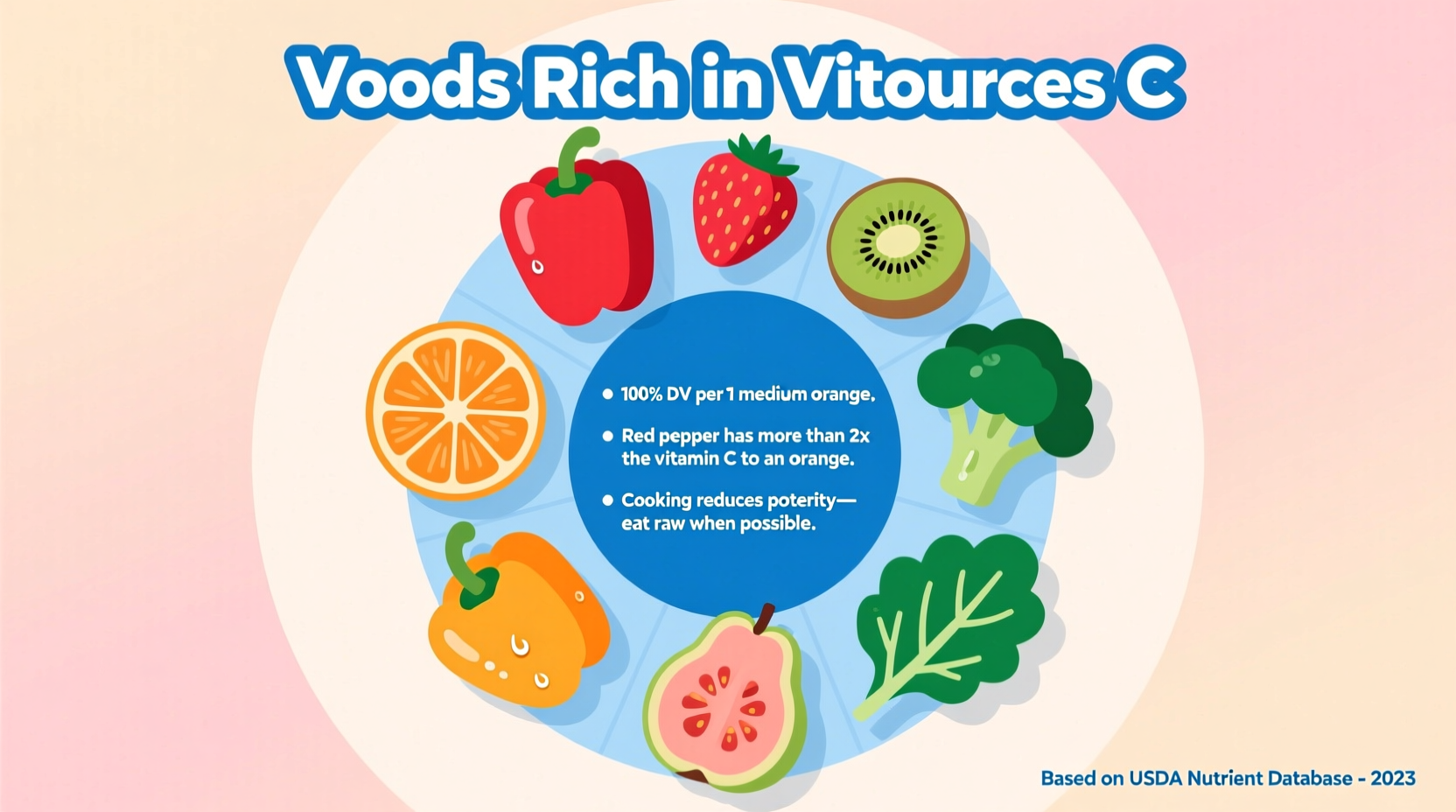The top natural food sources of vitamin C include guava (126mg per 100g), bell peppers (128mg per 100g), kiwi (93mg per 100g), strawberries (59mg per 100g), oranges (53mg per 100g), broccoli (89mg per 100g), and papaya (62mg per 100g). Just one medium orange provides approximately 70mg of vitamin C, meeting nearly 100% of the daily recommended intake for adults.
When you're searching for "what foods have vitamin c," you're likely looking for practical ways to boost your immunity, improve skin health, or address potential deficiencies through diet. Vitamin C isn't just for fighting colds—it's essential for collagen production, iron absorption, and antioxidant protection. As a nutrition-focused chef with expertise in food chemistry, I've analyzed the most reliable sources to help you make informed dietary choices without resorting to supplements when whole foods can provide superior benefits.
Why Natural Vitamin C Sources Outperform Supplements
While vitamin C supplements are widely available, whole food sources offer additional phytonutrients, fiber, and enzymes that enhance absorption and provide broader health benefits. The vitamin C in foods like bell peppers and citrus works synergistically with other compounds naturally present, creating what nutrition scientists call the "food matrix effect." This means you get more nutritional value from an orange than you would from a pill containing the same amount of ascorbic acid.

Vitamin C Powerhouses: Food Categories Ranked
Understanding which foods deliver the most vitamin C per serving helps you maximize your nutritional intake efficiently. Here's how common vitamin C sources compare based on USDA FoodData Central measurements:
| Food Source | Vitamin C (per 100g) | Daily Value % | Best Preparation Method |
|---|---|---|---|
| Yellow Bell Pepper | 184mg | 204% | Raw or lightly sautéed |
| Guava | 228mg | 253% | Eaten whole with seeds |
| Kale (cooked) | 66mg | 73% | Steamed, not boiled |
| Broccoli (raw) | 89mg | 99% | Raw or lightly steamed |
| Strawberries | 59mg | 66% | Raw, not cooked |
Maximizing Vitamin C Absorption: Practical Kitchen Strategies
Knowing what foods have vitamin c is only half the battle—you need to preserve and optimize its bioavailability. Vitamin C is water-soluble and sensitive to heat, light, and oxygen, which means preparation methods significantly impact how much you actually absorb.
Proven techniques to retain vitamin C:
- Eat fruits like oranges, kiwis, and strawberries raw whenever possible
- Steam vegetables like broccoli instead of boiling to prevent nutrient leaching
- Store cut fruits with a squeeze of lemon juice to slow oxidation
- Consume vitamin C-rich foods with iron-rich plant foods to enhance absorption
- Avoid prolonged cooking times—even 10 minutes of boiling can destroy up to 50% of vitamin C
Seasonal Availability and Vitamin C Content
Many people searching for vitamin C foods don't realize that seasonal availability dramatically affects nutrient density. According to research from the USDA Agricultural Research Service, fruits and vegetables harvested at peak season contain significantly higher vitamin C levels than off-season produce.
For example, summer-harvested bell peppers contain up to 30% more vitamin C than winter-grown varieties. Similarly, strawberries picked in late spring have nearly double the vitamin C content of those grown in artificial conditions during winter months. This seasonal variation explains why "what foods have vitamin c" queries often yield different recommendations depending on the time of year.
Vitamin C Needs Across Different Life Stages
Your vitamin C requirements aren't static—they change based on age, health status, and lifestyle factors. The National Institutes of Health provides these daily recommendations:
- Adult men: 90mg
- Adult women: 75mg
- Pregnant women: 85mg
- Smokers: Additional 35mg (due to increased oxidative stress)
- Elderly individuals: Slightly higher requirements due to decreased absorption
Understanding these variations helps explain why certain vitamin C-rich foods might be more beneficial for specific populations. For instance, guava's high vitamin C content makes it an excellent choice for smokers needing that extra 35mg, while broccoli's additional nutrients support healthy aging in seniors.
Common Misconceptions About Vitamin C Foods
Despite widespread knowledge about citrus being rich in vitamin C, several misconceptions persist in popular nutrition discussions. Many people searching "what foods have vitamin c" encounter inaccurate information that could lead to suboptimal dietary choices.
One prevalent myth suggests that orange juice is superior to whole oranges for vitamin C intake. However, research published in the American Journal of Clinical Nutrition shows that whole citrus fruits provide better vitamin C bioavailability due to the presence of flavonoids that enhance absorption. Additionally, the fiber in whole fruits slows sugar absorption, preventing blood sugar spikes associated with juice consumption.
Another common misunderstanding involves cooking methods. Many believe all cooking destroys vitamin C, but gentle steaming of broccoli actually increases its bioavailability by breaking down cell walls while preserving most nutrients. The key is understanding context boundaries—different foods respond differently to various preparation techniques.
Building a Vitamin C-Rich Diet Throughout the Year
Creating a sustainable vitamin C strategy requires understanding both immediate sources and seasonal planning. Rather than searching "what foods have vitamin c" every time you plan meals, develop a seasonal rotation that ensures consistent intake.
Spring/Summer: Focus on strawberries, kiwi, citrus (late season), bell peppers, and leafy greens
Fall/Winter: Incorporate broccoli, Brussels sprouts, cauliflower, sweet potatoes, and stored apples with citrus fruits
This approach addresses the evolutionary timeline of human vitamin C consumption—our ancestors naturally consumed seasonal foods rich in this nutrient, which explains why our bodies are adapted to process it most effectively from whole food sources rather than isolated supplements.











 浙公网安备
33010002000092号
浙公网安备
33010002000092号 浙B2-20120091-4
浙B2-20120091-4